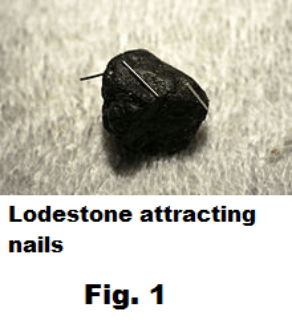
Website owner: James Miller
Magnetism. Magnetic domains. Magnetic fields, lines of force. Magnetic flux, flux lines. Magnetic transparency and magnetic permeability. Coulomb’s law. CGS unit pole. Magnetic field intensity. Dipole. Dipole moment. Torque on a dipole in a magnetic field. Terrestrial magnetism. Angle of declination. Magnetic inclination.

A type of rock called lodestone has the property of attracting pieces of iron — a fact known to the ancient Greeks (the Greek philosopher Thales of Miletus, 6th century BC, made mention of the fact). See Fig. 1. Lodestone is a rock (a type of magnetite) that was found in a section of Turkey then called Magnesia. The ancient Chinese discovered that splinters of this same rock, if hung at their midpoint by a thread, would always align themselves in a north-south direction. By the time of the T’ang Dynasty (7-8th century AD) the Chinese had learned how to magnetize iron needles by rubbing them with lodestone. They had also learned that needles cooled from red hot while held in a north-south orientation would become magnetized. They then floated these magnetized needles on water, placed them on a pointed shaft, or suspended them from a thread to form a compass and used compasses for guiding their ships. By 1000 AD their ships were sailing as far as Saudi Arabia.
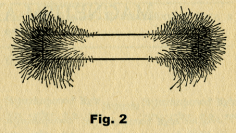
A piece of iron or steel can be magnetized by rubbing it always in the same direction by either end of a splinter of lodestone. It can also be magnetized by heating it to red hot and then letting it cool while oriented in a north-south direction.
Magnetic substances. Substances that are attracted by a magnet are said to be magnetic. Iron and steel are the most important magnetic substances, however some other substances are also noticeably (but not nearly as strongly) attracted, namely nickel, cobalt and certain alloys. Most common substances such as wood, copper and glass are only very, very slightly attracted by a magnet and are said to be paramagnetic. A few substances such as zinc and bismuth are feebly repelled and are said to be diamagnetic. Both paramagnetic and diamagnetic substances are often called nonmagnetic.
Magnetic polarity. If we lay a bar magnet in a pile of iron filings and then lift it we will discover that the filings cling to the magnet at or near the ends only. See Fig. 2. The attractive forces seem to be located at only two places — at the two ends of the magnet. These are called the poles of the magnet. If we suspend a magnetized steel bar or needle at its midpoint by a thread so that it turns freely, it will come to rest in a north-south direction (as occurs with the needle of a compass). The end that points north is called the north-seeking pole, north pole or N-pole and the end that points south is called the south-seeking pole, south pole, or S-pole.
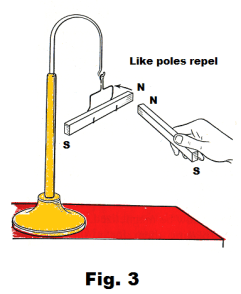
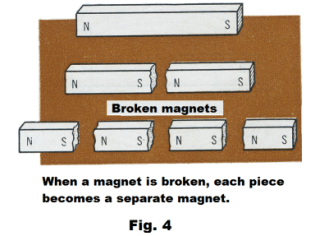
Attraction and repulsion between magnetic poles. In Fig. 3 we bring the north pole of one bar magnet near the north pole of another bar magnet. We find that the poles repel each other. If we were to bring the south pole of one magnet close to the north pole of another magnet we would find that they attracted each other. While a piece of iron is always attracted to either pole of a magnet, it is found that two magnetic poles will either repel or attract each other depending on whether they are of the same or opposite types i.e. Rule: like poles repel each other, unlike poles attract each other. In addition, the force of the attraction or repulsion between the poles is directly proportional to the strengths of the poles and inversely proportional to the square of the distance between them. A magnetic pole is of unit strength if it repels an exactly similar pole one centimeter away with a force of one dyne.
Magnetic domains. If we break a magnet into several pieces, each piece will be a separate magnet with a north and south pole. See Fig. 4. If we assume that this remains true no matter how many pieces it is broken into and how short the pieces may be, then we conclude that magnetism must be a phenomenon occurring at the molecular or atomic level. It is theorized that a magnetic substance such as iron is composed of tiny individual magnetic units at the atomic level which are lying in random directions when the substance is unmagnetized and which become lined up, with all units pointing in the same direction, when the substance is magnetized. These tiny magnetic units are referred to as magnetic domains. See Fig. 5. Thus when we stroke an iron bar with a magnet
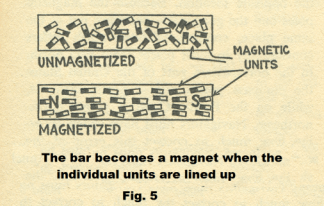
these magnetic units become lined up causing the bar to become magnetized.
Demagnetizing magnets. If we heat a magnet until it is red hot and place it in an east-west direction and let it cool, it will have lost nearly all of its magnetism. If we place a magnet in an east-west direction and tap it repeatedly with a hammer it will lose its magnetism. Magnets can also be demagnetized using alternating current.
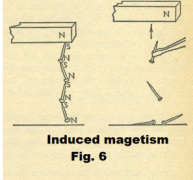
Temporary and permanent magnets. Pieces of soft iron or of silicon steel are easily magnetized, but they lose nearly all their magnetism in a very short time. They are said to have little retentivity. They are called temporary magnets. A piece of hard steel is difficult to magnetize but it holds its magnetism well. Its retentivity is high. It makes a good permanent magnet. Steel alloyed with tungsten also makes good permanent magnets. Most magnets being manufactured are alnico magnets, made from an alloy of iron, aluminum, nickle and cobalt. They are very powerful, can lift about 50 times their own weight, and retain their magnetism almost indefinitely. The method by which they are magnetized is to place them in contact with strong electromagnets for a short time.
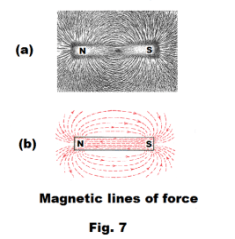
Induced magnetism. If we hold a bar magnet near or in contact with a soft iron nail, the nail becomes a magnet by induction. A steel magnet can be made to pick up several nails, chain fashion, as shown in Fig. 6. Induced magnetism is produced in each nail. If the top nail is held and the magnet is removed, the chain of nails will fall apart.
Magnetic fields, lines of force. A permanent magnet will exert a force on a piece of iron or on another magnet some distance away. The space around magnets, where their effects are felt, is called a magnetic field. This magnetic field is strongest near the magnet or magnets that cause it, but it extends out indefinitely into the surrounding space.
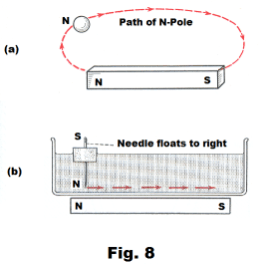
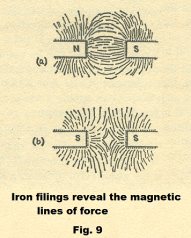
Let us place a smooth piece of cardboard on top of a bar magnet, sprinkle iron filings evenly over the cardboard and then tap the board gently. The filings will arrange themselves along curved lines as shown in Fig. 7(a). These curved lines represent magnetic lines of force. Fig. 7(b) is a schematic diagram of the lines of force. If we conceive of an imaginary independent north-seeking pole (north pole with no associated south pole) placed near a north pole of a bar magnet, it would move along a line of force towards the south pole as shown in Fig. 8(a). Although an independent N-pole is impossible, an approximation can be obtained of the path it would take through an experiment using Mayer’s floating magnet. The floating magnet consists of a magnetized sewing needle thrust through a piece of cork large enough to float the needle. A bar magnet is placed beneath a trough of water in which the needle floats as shown in Fig. 8(b). Because the south pole of the needle is so much further from the magnet than the north pole, the path taken by the needle as it floats from the north pole of the magnet to the south pole approximates a line of force curve.
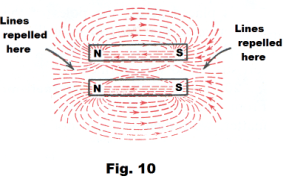
Fig. 9(a) shows iron filing patterns produced from the north and south poles of two bar magnets placed near each other. Fig. 9(b) shows a pattern from two adjacent south poles. Note that the lines of force are repelling each other. Fig. 10 gives a picture of the force field between two bar magnets laid side by side with like poles adjacent. Note that between the magnets the lines of force repel each other
Properties of magnetic lines of force:
1) They are closed curves which extend from the north pole to the south pole through the air and then return back to the north pole through the magnet.
2) They repel one another and do not cross each other.
3) They are concentrated near the poles of the magnet signifying that the magnetic field is much stronger there.
Magnetic flux, flux lines. Magnetic lines of force are also called flux lines. A line of force (or flux line) is so drawn that a tangent to it at any point corresponds to the direction of the magnetic field at that point. The lines of flux in a magnetic field are collectively called the magnetic flux. The unit of magnetic flux in the MKS system is the weber.
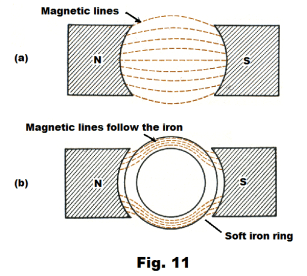
1 weber = 108 lines of flux
The magnetic flux density at a point is the number of flux lines per unit area at that point. Flux density in the MKS system is expressed in webers per meter2 and determines the field intensity at the point. The magnetic field intensity at a point is the force exerted by the field on a unit N pole at the point.
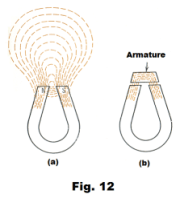
Magnetic transparency and magnetic permeability. Magnetic flux passes readily through nonmagnetic materials such as glass, wood, copper, tin, lead, zinc, etc. It passes through them as though they weren’t there. These substances are said to be transparent to magnetic flux — they permit the passage of magnetic flux similar to the way glass allows the passage of light. In contrast a magnetic substance such as iron is not transparent to magnetic flux. The flux does not pass through iron, but rather enters into it readily and follows a path within it. Fig. 11(a) shows the magnetic flux crossing the air gap between the poles of a horseshoe magnet. In Fig. 11(b) a soft iron ring has been placed in the gap. It is seen that the flux follows the iron rather than crossing directly through the air gap. None of the flux goes through the air gap. Fig. 12(a) shows the magnetic field around a horseshoe magnet and Fig. 12(b) shows the field about the same magnet with an armature.
Iron has a very high permeability since it readily gathers in magnetic flux and affords an excellent path for its transmission. Air has a permeability of unity. The diamagnetic substances have permeabilities that are slightly less than unity and the paramagnetic substances have permeabilities that are slightly greater than unity.
Induced magnetism is magnetism produced in a magnetic substance such as iron by the influence of a magnetic field.
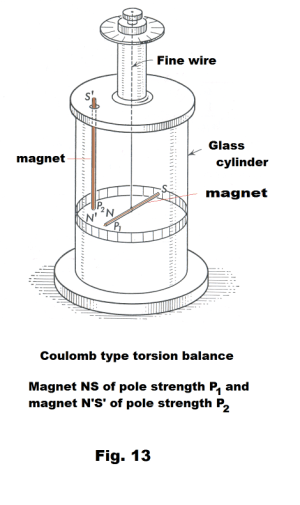
Coulomb’s law of force. Charles A. Coulomb, in the late 1700's, performed a number of experiments investigating the law of force existing between the poles of magnets. Using a torsion balance similar to that shown in Fig. 13, he suspended a long thin magnet (magnet NS with pole strength P1 in the figure) from a fine wire then, using a second long thin magnet (magnet N'S' with pole strength P2) studied the force between poles as a function of their pole strengths and of the distance between them. Measuring the amount of twisting of the suspended magnet under different experimental conditions, he arrived at the following law:
Coulomb’s law. The force between two magnetic poles is proportional to the product of the strengths of the poles and inversely proportional to the square of the distance between them:
![]()
where
p1 = pole strength of first magnet
p2 = pole strength of second magnet
r = distance between poles
k = constant of proportionality
F = force between poles
If p1 and p2 are of the same sign, F is positive and the force is one of repulsion. If p1 and p2 are of opposite signs, F is negative and the force is one of attraction.
MKS system of units. In the MKS system of units, Coulomb’s law is

where F is in newtons, p1 and p2 are in amp-meters, r is in meters, and μ0 = 4π×10-7. The unit of pole strength, the amp-meter, is defined implicitly by 2), letting p1 =1, p2 = 1, r = 1:
One amp-meter is a magnetic pole of such strength that when two like poles are placed one meter apart in a vacuum, they will repel each other with a force of μ0/4π nt.
CGS Electromagnetic system of units. In the CGS Electromagnetic system of units, Coulomb’s law is
![]()
where F is in dynes, p1 and p2 are in cgs poles, and r is in centimeters. A cgs unit pole is defined implicitly by 3):
Def. CGS unit pole. A cgs unit pole is a pole which placed one centimeter away from a like pole in a vacuum will repel it with a force of one dyne.
In the CGS Electromagnetic system, the force is stated in dynes and the pole strength is in cgs poles.
Magnetic field intensity at a point P (mks system). The magnetic field intensity at a point P is given by the force that would be exerted on a unit north pole if it were placed at the point.
In other words, if we were to introduce a small test north pole of pole strength p at a point P in a magnetic field using a long thin needle-like magnet and it experienced a force F at point P, then the magnetic field intensity B at point P is

(bold type and over-bar both used to indicate vector). The magnetic field intensity B is a vector quantity whose magnitude is given by the magnitude of the force on a unit north pole and whose direction is the direction of the force on the north pole. It is a measure of the magnetic flux at the point and is sometimes referred to as magnetic induction. It has units of webers/m2.
Magnetic field due to a point pole of strength p. The magnetic field intensity B at a point P located at a distance r from a point pole of strength p is

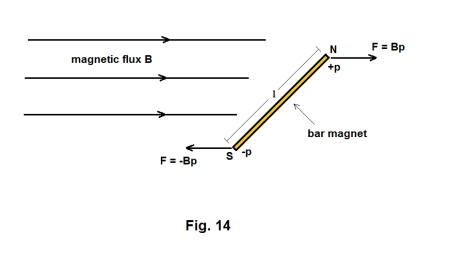
Dipole. Dipole moment. Torque on a dipole in a magnetic field. If we place a bar magnet of length l and pole strength p in a uniform magnetic field of strength B, the north pole of the bar will experience a force Bp in the direction of the field and the south pole will experience an equal force in the opposite direction. If the magnet is not parallel to the field, the magnet will experience a torque tending to rotate it so that it is parallel to the field. See Fig. 14.
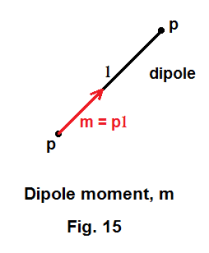
Def. Dipole. An entity with two poles of equal magnitude but opposite sign separated by a distance.
There are electric dipoles and magnetic dipoles. An example of an electric dipole is a dipolar molecule in which the center of negative charge is at some small distance away from the center of positive charge. An example of a magnetic dipole is a bar magnet with its north and south pole.
Def. Dipole moment. The dipole moment of a dipole with poles of strength p separated by a distance l is the vector m directed from the negative pole to the positive pole with the magnitude
5) m = pl
See Fig. 15. In the case of magnetic dipoles, the north pole is considered positive and the south pole negative. Thus the magnetic dipole moment of a bar magnet of length l and pole strength p is
6) m = pl
where m is a vector directed from the south pole to the north pole.
Torque of a dipole in a magnetic (or electric) field. The torque L experienced by a dipole of pole strength p and pole separation l in a uniform force field B is given by
7) L = Bpl sin θ = Bm sin θ
where θ is the angle that the vector m makes with the field B.
Written as a vector product, the torque is given by
8) L = m×B
where L is a vector perpendicular to M and B whose direction is given by the right hand rule.
Torque on a bar magnet in a magnetic field B. The torque L on a bar magnet of length l and pole strength p is
9) L = m×B
where m = pl.
Terrestrial magnetism. Why does a compass needle line up in a north-south direction? One must conclude that the earth is surrounded by a magnetic field. In fact, the earth acts as though it were a huge magnet. Why this is so is not known and is subject to speculation.
A compass needle does not point exactly to the north pole. It points to a point around 1200 miles south of the north pole located at approximately latitude 73o N , longitude 100o W — a point termed the North Magnetic Pole. The South Magnetic Pole is located at a point on the Antarctic plateau at approximately latitude 68o S, longitude 146o E.
Angle of declination. Because a compass needle does not point to true north from most locations on the earth, a correction must be made to the compass reading to find the direction to true north. This correction is called the angle of declination. The angle of declination is the angle between true north and the north shown by the compass needle.
Magnetic inclination. If one moves a small compass over a bar magnet, the needle will be level near the middle of the magnet but will dip near the ends. A compass needle mounted on a horizontal axis, and provided with a means of measuring the angle of the needle with the horizontal, is called a dipping needle. A dipping needle will show various amounts of dip at difference points on the earth. Approximately halfway between the magnetic poles the angle of dip is zero. The dip, or angle between the equilibrium position of a dipping needle and the horizontal, at a location is called the magnetic inclination at that location.
References
1. Dull, Metcalfe, Brooks. Modern Physics.
2. Freeman. Physics Made Simple.
3. Semat, Katz. Physics.
Jesus Christ and His Teachings
Way of enlightenment, wisdom, and understanding
America, a corrupt, depraved, shameless country
On integrity and the lack of it
The test of a person's Christianity is what he is
Ninety five percent of the problems that most people have come from personal foolishness
Liberalism, socialism and the modern welfare state
The desire to harm, a motivation for conduct
On Self-sufficient Country Living, Homesteading
Topically Arranged Proverbs, Precepts, Quotations. Common Sayings. Poor Richard's Almanac.
Theory on the Formation of Character
People are like radio tuners --- they pick out and listen to one wavelength and ignore the rest
Cause of Character Traits --- According to Aristotle
We are what we eat --- living under the discipline of a diet
Avoiding problems and trouble in life
Role of habit in formation of character
Personal attributes of the true Christian
What determines a person's character?
Love of God and love of virtue are closely united
Intellectual disparities among people and the power in good habits
Tools of Satan. Tactics and Tricks used by the Devil.
The Natural Way -- The Unnatural Way
Wisdom, Reason and Virtue are closely related
Knowledge is one thing, wisdom is another
My views on Christianity in America
The most important thing in life is understanding
We are all examples --- for good or for bad
Television --- spiritual poison
The Prime Mover that decides "What We Are"
Where do our outlooks, attitudes and values come from?
Sin is serious business. The punishment for it is real. Hell is real.
Self-imposed discipline and regimentation
Achieving happiness in life --- a matter of the right strategies
Self-control, self-restraint, self-discipline basic to so much in life